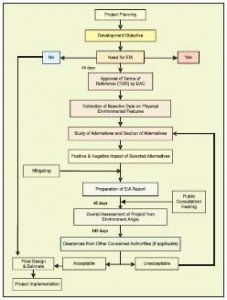 To complement India’s fast pace of economic growth, various infrastructure-development projects have been started by the government – the development of roads and highways being the key area of focus. Most of the time infrastructure-development ventures, including road and highway projects, pass through the Ecologically Sensitive Area and pose a threat to the biodiversity and natural resources of the area in which they are proposed to be constructed. Often, they disrupt the socio-economic setup of the area. In India, various rules and regulations related to environment protection and conservation to mitigate the eventuality arising out of these development projects exist. Yet, the Environment Impact Assessment (EIA) has emerged as the most famous tool in recent times as it focuses on the amalgamation of the environmental management into the decision making process for sustainable development.
To complement India’s fast pace of economic growth, various infrastructure-development projects have been started by the government – the development of roads and highways being the key area of focus. Most of the time infrastructure-development ventures, including road and highway projects, pass through the Ecologically Sensitive Area and pose a threat to the biodiversity and natural resources of the area in which they are proposed to be constructed. Often, they disrupt the socio-economic setup of the area. In India, various rules and regulations related to environment protection and conservation to mitigate the eventuality arising out of these development projects exist. Yet, the Environment Impact Assessment (EIA) has emerged as the most famous tool in recent times as it focuses on the amalgamation of the environmental management into the decision making process for sustainable development.
Earlier, the only criteria for the implementation of a project used to be the financial and technical feasibility of the project. On the 27th of January 1994, an EIA notification was issued under the Environment Protection Act, 1986 making EIA a statutory requirement for clearance of projects in India. With this notification, environmental feasibility and sustainability also became one of the few major factors of project planning and implementation. To further improve the efficacy of EIA, a Revised EIA notification was issued on September 14, 2006. It decentralised various projects/activities of the Central and State level administration, thus establishing a new threshold criteria for the projects requiring environmental clearance either at Central Government [Ministry of Environment and Forest (MoEF)] or State level.
The revised EIA Notification divides the industrial process/project/development/ infrastructure activities into eight major categories for Environmental Clearance (EC). These eight major categories have been further divided into Category ‘A’ and Category ‘B’ as per the threshold criteria stipulated under the notification. The categorisation of Projects and Activities has been based on the ‘spatial extent of potential impacts on human health and natural and man-made resources’.
The industrial projects/processes/development activities falling in Category ‘A’ are to be reviewed/appraised [through an Expert Appraisal Committee (EAC)] by MoEF at the Central Level while Category ‘B’ projects/activities will be reviewed/appraised by the State Environment Impact Assessment Authority (SEIAA) through a duly constituted State Level EAC. The ‘Category B’ projects/activities have been further divided into Category ‘B1’ and Category ‘B2’ projects. The Category ‘B1’ projects/activities require EIA studies to be carried out and EIA report to be submitted as per the format specified under the revised EIA notification. Based on the recommendations of State Level SEAC, Category ‘B2’ projects will not require EIA studies/report for obtaining EC from SEIAA. It is also stipulated that under ‘General Condition’ (GC), any project or activity specified in Category ‘B’ will be treated as Category ‘A’ if located in whole or in part within 10 km from the boundary of (i) Protected Areas notified under the Wildlife (Protection) Act, 1972, (ii) Critically Polluted areas as ‘notified’ (changed to ‘identified’ as per Dec 1, 2009 Amendments of the EIA notification of Sept 14, 2006) by Central Pollution Control Board (CPCB) from time to time, (iii) Notified eco–sensitive areas, and (iv) inter-state boundaries and international boundaries.
The ‘Prior Environmental Clearance’ (EC) Process for new as well as expansion/up-gradation/modification of existing projects/activities (including road and highway projects) comprises four steps/stages. They are:
(1) Screening (only for category ‘B’ projects to be appraised at State Level by SEAC) and activities to go forward with further EIA studies for preparation of EIA depending upon nature and location specificity of the project, except in the case of township and area development projects;
(2) Scoping which includes determination of detailed Terms of Reference (TOR) addressing all relevant environmental concerns for preparation of EIA report for the project for which environmental clearance is sought – on the basis of information furnished by the applicant in the prescribed format which will be displayed on the website of MoEF and SEIAA as the case may be;
(3) Public Consultation which requires all category A and Category B1 projects/activities to undertake Public Consultation except in modernisation of irrigation projects, those located within industrial estates or parks, expansion of roads and highways with no further acquisition of land, building/construction projects/area development projects/townships, all category B2 projects/activities and finally those concerning defence and security or involving other strategic considerations – it has been further specified that ‘Public Consultation’ has to be carried out at the ‘Site’ or in ‘close proximity’ and after obtaining responses in written format from the project affected persons (PAPs); and
(4) Appraisal which is carried out on the basis of final EIA report and outcome of ‘Public Consultation’ including ‘Public Hearing’. It is at this stage that the decision on granting or rejecting EC is taken and conveyed to the applicant within the stipulated period. (see figure)
In India, roads and highways are major components of infrastructural development. With 30 millon km of road length, Indian roads are second largest in the world after USA but India still lags behind in providing ‘all-weather roads’ to 40% of its villages. For providing connectivity to the villages and further strengthening the roads and highways network, the National Highway Authority of India (NHAI) has gone ahead with phase-wise development under National Highway Development Programme (NHDP).
 Like any other infrastructural development project/activity during road and highway projects’ developmental phases (viz., Pre-construction, Construction and Operational phase) project location, route alignment and their associated activities are invariably accompanied by significant environmental and social impact which can either be positive or negative. In order to mitigate the adverse impact of the road and highway projects on the environment, it is imperative to consider the environmental impact of highway projects at all stages. Road and highway projects come under the purview of EIA Notification. They have been kept in Category ‘7f’ and are appraised both at the centre (Category A) as well as the state level (Category B) depending upon the criteria specified under the notification. They have to undergo EC procedure like any other project, depending on the Category (A or B) of the project. As per the EIA notification, as applicable to road and highway projects, cost criterion which earlier used to be the criterion of categorisation, has been replaced with other threshold criteria related to length of National/State Highways (NHs/SHs) with additional right of way (ROW) requirement and applicability of General Conditions (GCs). Accordingly, New NHs and also expansion of NHs by > 30km, involving additional ROW than 20m involving land acquisition, and passing through more than one state, should necessarily obtain EC from Central Government (Category A). Likewise, new SHs along with expansion of NHs/SHs by > 30km, involving land acquisition (within one state) may obtain EC from SEIAA (Category B1).
Like any other infrastructural development project/activity during road and highway projects’ developmental phases (viz., Pre-construction, Construction and Operational phase) project location, route alignment and their associated activities are invariably accompanied by significant environmental and social impact which can either be positive or negative. In order to mitigate the adverse impact of the road and highway projects on the environment, it is imperative to consider the environmental impact of highway projects at all stages. Road and highway projects come under the purview of EIA Notification. They have been kept in Category ‘7f’ and are appraised both at the centre (Category A) as well as the state level (Category B) depending upon the criteria specified under the notification. They have to undergo EC procedure like any other project, depending on the Category (A or B) of the project. As per the EIA notification, as applicable to road and highway projects, cost criterion which earlier used to be the criterion of categorisation, has been replaced with other threshold criteria related to length of National/State Highways (NHs/SHs) with additional right of way (ROW) requirement and applicability of General Conditions (GCs). Accordingly, New NHs and also expansion of NHs by > 30km, involving additional ROW than 20m involving land acquisition, and passing through more than one state, should necessarily obtain EC from Central Government (Category A). Likewise, new SHs along with expansion of NHs/SHs by > 30km, involving land acquisition (within one state) may obtain EC from SEIAA (Category B1).
‘General Conditions’ in the aforementioned notification also apply to road projects. Certain amendments have been introduced in the EIA Notification of 2006 on December 01, 2009 with modification in different categories including category ‘7f’. Under this, construction of new state highway projects and state highway expansion projects in hilly terrain (above 1,000m AMSL) and/or ecologically sensitive areas is to be considered as category B. Highways also include expressways which have been exempted earlier from EIA Study. The process of prior Environmental Clearance of road/highway projects is similar to any other project. EIA/Environment Management Plan (EMP) studies aid in decision making and project implementation process to avoid/mitigate the negative impacts and enhance positive impacts, sustainability and developmental benefits during the design stage.
 Anuradha Shukla
Head, Transport Planning and Environment
Central Road Research Institute
Anuradha Shukla
Head, Transport Planning and Environment
Central Road Research Institute
 TrafficInfraTech Magazine Linking People Places & Progress
TrafficInfraTech Magazine Linking People Places & Progress

